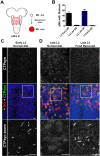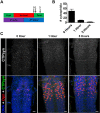Nucleotide synthesis is regulated by cytoophidium formation during neurodevelopment and adaptive metabolism
- PMID: 25326513
- PMCID: PMC4232762
- DOI: 10.1242/bio.201410165
Nucleotide synthesis is regulated by cytoophidium formation during neurodevelopment and adaptive metabolism
Abstract
The essential metabolic enzyme CTP synthase (CTPsyn) can be compartmentalised to form an evolutionarily-conserved intracellular structure termed the cytoophidium. Recently, it has been demonstrated that the enzymatic activity of CTPsyn is attenuated by incorporation into cytoophidia in bacteria and yeast cells. Here we demonstrate that CTPsyn is regulated in a similar manner in Drosophila tissues in vivo. We show that cytoophidium formation occurs during nutrient deprivation in cultured cells, as well as in quiescent and starved neuroblasts of the Drosophila larval central nervous system. We also show that cytoophidia formation is reversible during neurogenesis, indicating that filament formation regulates pyrimidine synthesis in a normal developmental context. Furthermore, our global metabolic profiling demonstrates that CTPsyn overexpression does not significantly alter CTPsyn-related enzymatic activity, suggesting that cytoophidium formation facilitates metabolic stabilisation. In addition, we show that overexpression of CTPsyn only results in moderate increase of CTP pool in human stable cell lines. Together, our study provides experimental evidence, and a mathematical model, for the hypothesis that inactive CTPsyn is incorporated into cytoophidia.
Keywords: CTP; CTP synthase; Drosophila; cytoophidium; intracellular compartmentation; neurogenesis.
© 2014. Published by The Company of Biologists Ltd.
Conflict of interest statement
Figures






Similar articles
-
CTP synthase: the hissing of the cellular serpent.Histochem Cell Biol. 2022 Dec;158(6):517-534. doi: 10.1007/s00418-022-02133-w. Epub 2022 Jul 26. Histochem Cell Biol. 2022. PMID: 35881195 Free PMC article. Review.
-
The Interplay between Myc and CTP Synthase in Drosophila.PLoS Genet. 2016 Feb 18;12(2):e1005867. doi: 10.1371/journal.pgen.1005867. eCollection 2016 Feb. PLoS Genet. 2016. PMID: 26889675 Free PMC article.
-
MicroRNA regulation of CTP synthase and cytoophidium in Drosophila melanogaster.Exp Cell Res. 2019 Dec 15;385(2):111688. doi: 10.1016/j.yexcr.2019.111688. Epub 2019 Nov 1. Exp Cell Res. 2019. PMID: 31678212
-
Regulation of CTP Synthase Filament Formation During DNA Endoreplication in Drosophila.Genetics. 2015 Dec;201(4):1511-23. doi: 10.1534/genetics.115.180737. Epub 2015 Oct 19. Genetics. 2015. PMID: 26482795 Free PMC article.
-
The Cytoophidium and Its Kind: Filamentation and Compartmentation of Metabolic Enzymes.Annu Rev Cell Dev Biol. 2016 Oct 6;32:349-372. doi: 10.1146/annurev-cellbio-111315-124907. Epub 2016 Jun 27. Annu Rev Cell Dev Biol. 2016. PMID: 27362644 Review.
Cited by
-
CTP synthase: the hissing of the cellular serpent.Histochem Cell Biol. 2022 Dec;158(6):517-534. doi: 10.1007/s00418-022-02133-w. Epub 2022 Jul 26. Histochem Cell Biol. 2022. PMID: 35881195 Free PMC article. Review.
-
Fat body-specific reduction of CTPS alleviates HFD-induced obesity.Elife. 2023 Sep 11;12:e85293. doi: 10.7554/eLife.85293. Elife. 2023. PMID: 37695169 Free PMC article.
-
The Interplay between Myc and CTP Synthase in Drosophila.PLoS Genet. 2016 Feb 18;12(2):e1005867. doi: 10.1371/journal.pgen.1005867. eCollection 2016 Feb. PLoS Genet. 2016. PMID: 26889675 Free PMC article.
-
CTP Synthase Is Required for Optic Lobe Homeostasis in Drosophila.J Genet Genomics. 2015 May 20;42(5):261-74. doi: 10.1016/j.jgg.2015.04.006. Epub 2015 May 18. J Genet Genomics. 2015. PMID: 26059773 Free PMC article.
-
Filamentation modulates allosteric regulation of PRPS.Elife. 2022 Jun 23;11:e79552. doi: 10.7554/eLife.79552. Elife. 2022. PMID: 35736577 Free PMC article.
References
-
- Aronow B., Ullman B. (1987). In situ regulation of mammalian CTP synthetase by allosteric inhibition. J. Biol. Chem. 262, 5106–5112. - PubMed
-
- Beaty N. B., Lane M. D. (1983a). Kinetics of activation of acetyl-CoA carboxylase by citrate. Relationship to the rate of polymerization of the enzyme. J. Biol. Chem. 258, 13043–13050. - PubMed
Grants and funding
LinkOut - more resources
Full Text Sources
Other Literature Sources
Molecular Biology Databases
Research Materials

